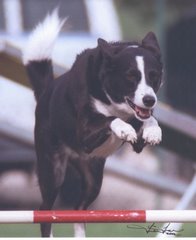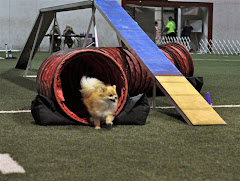This post is about some of the more common disease of the eye seen in pets.
Nuclear or Lenticular sclerosis is a normal age related change of the lens. This is what gives your older dog that hazy look in his eye. This causes no appreciable vision loss, is not a cataract and does not proceed to blindness.
Cataracts are an opacity of the lens. They can be congenital, inherited, secondary to diabetes, traumatic, secondary to other intraocular disease, or toxins. There are other less common causes as well. Rate of progression is very variable and can take from days to years to reach full maturity and blindness. Cataracts can be surgically removed but patients must undergo some other testing to make sure they are an appropriate candidate for this procedure.
Conjunctivitis is a very common ocular disorder. This in inflammation or reddening of the conjunctiva, or the pink fleshly lining of the eye, essentially "pink eye." This is most commonly caused by allergies, infection, foreign objects or other irritants. It can be associated with ocular discharge of various character-serous (clear), mucoid (mucus), or mucopurulent (pus-like mucus). It is typically treated with drops or ointment containing a steroid plus or minus an antibiotic and usually resolves uneventfully. Some dogs with chronic allergies use these drops on a regular or as-needed basis. This can occur in one or both eyes.
Corneal ulcers are a scratch or defect in the cornea-the clear covering of the eye. This can be caused by any number of things-cat scratch, dog pawing at it's eye, running through the weeds/brush, etc. Uncomplicated superficial ulcers usually heal quickly and with no complications. They are treated with antibiotic drops and sometimes anti-inflammatory pain medications. E-collars are frequently placed if the animal is bothering the eye. Deep, infected, or chronically non-healing ulcers are treated more aggressively because the more weakened the cornea is the more chance there is for rupture of the cornea-a very serious side effect. These are often treated with more powerful antibiotics, serum from the dog's own blood, and various surgical procedures depending on the situation. Some of these are even serious enough to be treated by a specialist. Corneal ulcers are especially prevalent in dogs like pugs or boston terriers due to their ocular conformation.
Keratoconjunctivitis sicca (KCS) or Dry Eye is a deficiency of tear production. This leads to inflammation of the cornea and conjunctiva with secondary ulcers, infection, and pigmentation of the cornea. This a disease that is very painful left untreated and typically requires life-long therapy. Causes can be congenital (rare), drug induced, autoimmune-mediated inflammation, endocrine and other systemic diseases. Diagnosis is made by measuring the amount of tears produced in a minute. A strip of paper is placed under the lower eyelid which has millimeters marked on it with a dye. As the tear fluid flows up the paper the dye is diluted and shows "how many" tears the pet has made. Treatment is aimed at clearing up any infection and keeping the eye hydrated. Artificial tears are used as often as possible, especially in the early stages. Topical cyclosporine is the gold standard of treatment and helps to increase the tear production of the affected eye. Other options are available if cyclosporine does not work but can be very expensive.
Glaucoma is a painful condition where the pressure inside the eye rises above normal. The pressure rises because of an increased production of the fluid inside the eye, or an inability for the fluid to drain. This condition, in addition to causing discomfort, can lead to blindness. Signs of glaucoma include a dilated pupil, reddening of the conjunctiva, enlargement of the eye, a blue color to the eye and signs of pain or vision loss. Treatment for glaucoma varies widely from patient to patient based on time of presentation ( if caught early enough, emergency treatment can be instituted to save vision), goal of the owner (maintain comfort vs. vision vs. maintain eye), demeanor of the dog (many topical meds will need to be given) and financial limitations. Treatment can include hospitalization, referral to a specialist, medications, and or surgery up to and including removal of the eye.
Most often ocular related problems are simple and non-emergent. But because some of them are truly emergencies and require aggressive therapy is it best not to "wait and see" when your dog is having an eye problem. Sometimes even a matter of a few hours can make a difference and there is not a way to tell over the phone if your pet is having one of those problems. As you have noticed a lot of eye problems can present as redness and squinting-but some are more serious than others!
Summer
1 year ago


.jpg)
.jpg)



.jpg)



2 comments:
Right now we have several cases of allergy eyes, including my own.
Interesting post. Misty has cataracts, and both dogs get conjunctivitis in the summertime.
Post a Comment